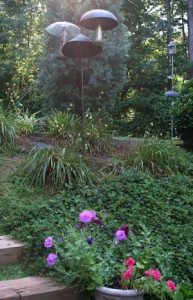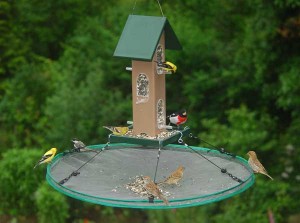-
unique birdhouses can be edible
So many houses… and so little time!
With Valentine’s Day fast approaching, gifts of nature are always a perfect choice for bird-lovers, garden addicts and the like. Hmmmm… Bird house or bird feeder?
This groovy Wren Casita is both! A real, full-size wooden wren house is revealed once the premium birdseed has been consumed. Layered with millet, safflower and sunflower, it proves a tasty treat for your avian amigos. Chickadees, finches, and titmice are a few who will flock to this feeder. These unique birdhouses may be painted in a whimsical design, stained, or just left natural to weather over time. The decorative flowers and stems on the Wren Casita may be used by some birds for nest material as well.
For use as feeder, just hang this unique birdhouse from a tree limb or hanger in view where you’ll be able to watch the action. As with all bird seed, best results will be obtained when it’s protected from the elements and pesky squirrels. For use as a birdhouse, simply hang the Wren Casita in a secluded part of the yard, or mount to a post or tree trunk approximately six to ten feet from the ground.
Surprise your Valentine with an edible birdhouse that will provide a critical nesting site for many seasons to come. Please help house the birds!
-
easy bluebird bird house kits fledge successful broods!
In the Bluebird Monitor’s forum, there are reports of the first eggs laid in a Florida nest box. Well, this is just exciting news for anyone who’s into Bluebirds because it means that it won’t be too long before the blues are nesting further and further North!
Although Bluebird houses run the gamut from basic wooden box and recycled plastics, to more elaborate, and decorative houses, an important aspect to look for is approval by The North American Bluebird Society (NABS). Maybe you’ve seen that acronym before, and wondered what’s a NABS? Well, that’s who they are, and their website provides great information on attracting and housing Bluebirds.
If you’ve ever considered it, but haven’t yet tried… please do! These little brilliant blue birds are amazing, and so family-oriented that it’s just plain cool to have a group in your yard. You needn’t spend a lot either, bluebird bird house kits are available, and some are even NABS Approved. Although it’s difficult to spot in this photo of our yard, look in the upper right corner and you’ll see a bluebird bird house kit that’s been in business for years. It’s mounted on a simple piece of conduit, and does have a baffle added for protection from predators. A tad taller than most recommended heights (5 to 6 feet from the ground), our birds seem to like it just fine. This bird house kit actually fledged three groups of nestlings last season. In the photo it appears to be near the treeline in back, but in reality it stands in open space. That’s another requirement for bluebirds to nest – some open space (which doesn’t cost anything at all).
A fantastic reference for all things Bluebird-related is a website called Sialis. I think it’s actually the Latin term for Blue Bird? Virtually any question concerning Bluebirds (and some other cavity nesters) may be found here. It’s well organized and referenced in plain English, so even the novice blue-birder walks away with useful information to benefit our precious “Blues”.
Please help house the birds! 🙂
-
Seed Catchers promote healthier birds
When spilled birdseed sits on the ground for a few days, it gets nasty. Combine that with some rain and warmer temperatures, (like we’ve been having in the south) and you get insta-mold. That’s my word for quickly-molding, bacteria producing, old seed. Ground feeding birds like some sparrows, juncos and even cardinals will forage through this nasty stuff looking for a decent bite to eat. Thus, bacteria and germs are spread amongst your backyard birds. The result is usually a respiratory infection and many time turns into conjunctivitis. In birds, this disease is usually fatal.
Aside from keeping feeders themselves clean, it’s important to be aware of the entire feeding area, including the ground below your bird feeders. Seed Catchers greatly reduce spilled seed, while keeping the appearance of your yard nicer. Eliminating the ground mess below feeders really does promote healthier birds.
The large seed catcher shown here features an adjustable and innovative design. Known as the Seed Hoop, it works virtually with any bird feeder, whether hanging or pole-mounted. Available in a 16-inch diameter, it accommodates most tube-style feeders, even those hung on a shepherd’s hook. The larger 30-inch diameter may actually be pole-mounted below the feeder by cutting a slit in the center of the seed tray. If this is the desired use, it’s best to place some duct tape around the slit, and here’s why: We’ve had the 30-inch seed catcher installed on the pole itself with a finch feeder above. Over several months, this center hole has gotten larger from removing and replacing the tray for cleaning. Besides… duct tape fixes everything, right?



